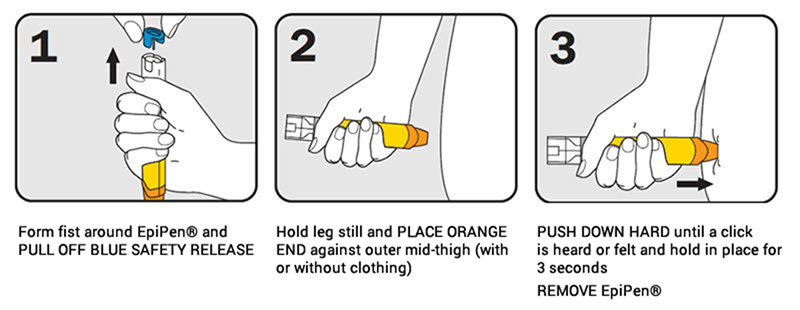Knowing how to use an EpiPen is important.
Doctors are seeing more and more patients with allergies, especially food allergies. Due to the unpredictable nature of allergic reactions, epinephrine auto-injectors (EpiPens) are prescribed.
EpiPens deliver medicine quickly and effectively.
When and How?
A lot of times, allergic reactions are mild and only affect one part of your body. You might get a rash, a runny nose or itchy eyes, for example. But for people with certain allergies, contact with the substance they are allergic to could trigger a dangerous, even life-threatening, reaction. An EpiPen is an epinephrine auto-injector for emergency treatment of severe allergic reaction, also known as anaphylaxis. It’s important to know how to use an EpiPen before you ever need it.
An epinephrine injection is your first line of defense against a severe allergic reaction because the quicker you treat it, the less intense it’s likely to become.
When left untreated, however, a severe allergic reaction can become fatal. And remember, using an EpiPen does not replace seeing a health care provider or going to the hospital.

How to Administer Medication — Press, Click, Hold
Someone with known allergies or a history of anaphylaxis should carry a prescribed epinephrine auto-injector at all times. If an emergency arises, administer the injection and have someone call 9-1-1 immediately so you can be taken to the nearest emergency department by ambulance. Here’s a step-by-step guide to proper use.
Here it is:
Place the orange tip against the middle of the outer thigh (upper leg) at a right angle (perpendicular) to the thigh. Swing and push the auto-injector firmly until it “clicks.” The click signals that the injection has started. Hold firmly in place for 3 seconds (count slowly 1, 2, 3).
- Take the pen out of the carrier tube and remove the cap.
- Grip the tube in your fist with the orange end facing downward. (Remember, blue to the sky, orange to the thigh)
- Remove the blue safety cap with your free hand, pull it straight off, do not twist it.
- Give the shot through clothing or directly into the skin.
- Firmly press the orange end into the outer thigh until it clicks.
- Hold it in place at a 90-degree angle for 3 seconds, counting slowly.
- Pull the pen straight out of the leg.
- Make note of the time you administered the medication and pass this information along to the medical team.
Signs of a Severe Allergy
When the immune system is triggered by allergens, the body reacts. Unfortunately, symptoms are not always obvious or immediate.
Symptoms of anaphylaxis:
- Swelling of the throat
- Difficulty breathing or swallowing
- Shortness of breath
- Wheezing
- Belly Pain
- Chest tightness
- Dizziness
- Vomiting
- Confusion
- Low heart rate and blood pressure
- Severe hives or rash
- Itchy, swollen eyes or tongue
While you’ve probably heard the term EpiPen used to refer to an epinephrine autoinjector, EpiPen is a brand name. Other companies use different brand names for their epinephrine autoinjectors, such as AUVI-Q and SYMJEPI.
Some doctors recommend taking an allergy antihistamine pill, rather than using an autoinjector, if you only have symptoms on the outside of your body, such as a rash or hives. You can talk to your doctor about what’s right for you. If you’re not sure, use the epinephrine autoinjector.
Read more about allergies here.
Book a consultation by calling us on 302-407-5222 just walk in, if you’re in the area.
